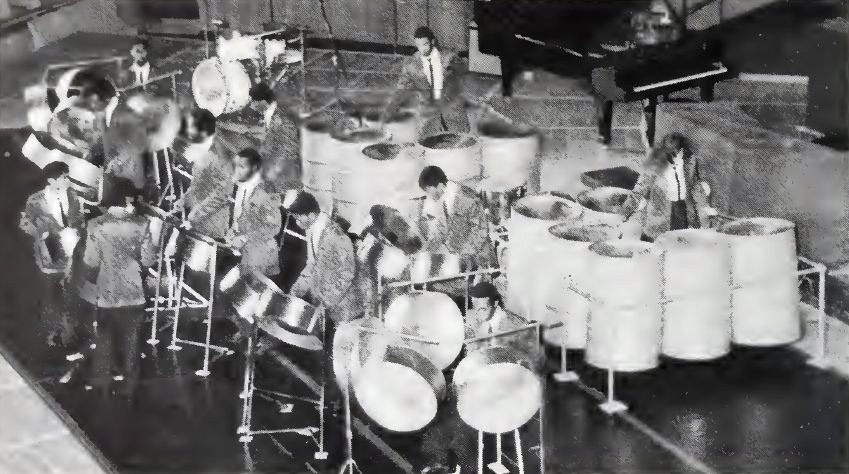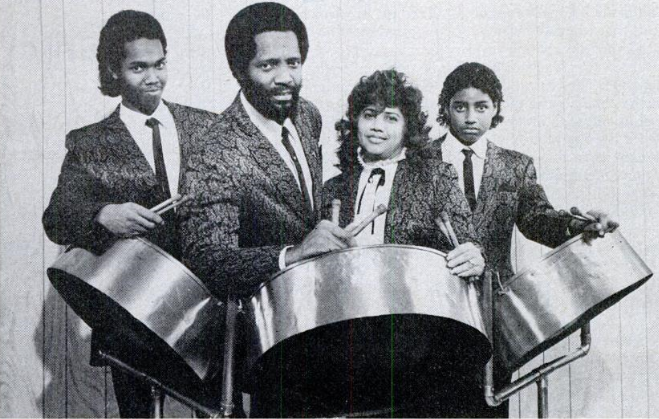Oral History

The Johnston Fantastic Symphony Steel
Orchestra at the United Nations General Assembly Hall - September
17, 1982
1985 interview:
Herman Johnston was born in Trinidad 48 years ago. Looks can be deceiving because Mr. Johnston could easily win a body building contest as the “Black Hulk”. With a figure like his, one might say he is In the wrong profession. He is a man of strong convictions, determined to have the steel pan recognized as a musical instrument capable of playing any type of music. Mr. Johnston does not want the steel pan to get lost in the shuffle being associated only with Rum and Coca-Cola, sandy beaches and windward breezes.
According to the classification of instruments, the steel pan is a struck melodic idiophone, capable of producing some of the most mellifluous tones to have been parented form a discarded oil vat and the creative musical genius of black people.
Mr. Johnston prefers the spider-web pan over the Mannette-style because of its codified structure. The spider-web pan is constructed in cycles of fifths wherein any major triad or chord can be built from the starting key then moving upward (to the right) four notes to get the second tone, then downward (to the left) three notes to get the third tone of the triad. To complete the octave, one moves a note, from the last note of the triad, to the left and the octave is completed. This symmetry is the same for all chords. Therefore, one can change the key of a selection merely by changing the starting key without altering the pattern of the ensuing notes. The structure of this pan is an ingenious innovation where in movements to the right yield places on the staff of sharps in sharp keys - F C G D A E B, and movements to the left yield places on the staff of flats in flat keys - B E A D G C F. How musical is man? If we ask that question of Anthony Williams, the creator of the spider web pan, one would have to say he surpassed musical wizardry in constructing this sonorous symmetry on a discarded oil vat.

Anthony Williams (right) introduced the
“spider web” lead Pan. The instrument shown off here by Williams and
Herman “Rock” Johnston was an amended version which Johnston claims to
have crafted and whose expanded range supposedly was the key to the
Williams-led North Stars band winning Trinidad’s 1962 Music Festival
with their memorable rendition of the Strauss Waltz, Voices of
Spring. -
See more
In Trinidad, Mr. Johnston was a member of the North Stars pan group, the first group to use the spider-web pan. The spider-web pan was created out of the shortcomings of the Mannette pan wherein a multi-note tenor pan did not give a full range of tones to play many of the classical selections. Therefore, a pan had to be developed where these ranges could be achieved. The creation of the cycles of fifths on the pan achieved those ranges. The Mannette pan had a better tone quality than the spider-web and was not sunk in to any great extent. Herman Johnston came in as tuner and gave the pan the depth it has today.
Steel pan players began having competitions and festivals wherein players would group together to vie for titles of best player, best group, best tone quality and road march. Adjudicators from England were sent to Trinidad to judge the competitions. As these competitions continued, groups would attempt to play classical selections on the pans. The pans did not contain a full range expanding over several octaves. Therefore, if a group chose to play “Voices of Spring,” the high notes would be out of the range of the pan. The players would drop the high notes down a octave to suit the range of their pans. According to Mr. Johnston, in 1958 the adjudicators suggested that pan players should stick to their own music, calypso, instead of attempting the classics.
In 1962, Herman Johnston started making the pans for the North Stars. This was the first time that the classics would be played successfully on the pan - reaching the full range of the high notes of the classics. According to Mr. Johnston, around that time the lead pan became nicknamed the piano pan because it was able to reach the high tones and had more clarity. The North Stars won for best tone quality which made the adjudicators swallow their words. This was a new breakthrough in steel pan, and new technique in pan tuning.
After leaving the Pan Am North Stars, Mr. Johnston formed a group called West Side Symphony (BWIA Sun Jets). Ten months hence, he won a music festival, not a competition, but a festival. Such a feat had never been accomplished before in such a short span of time. The Trinidad Daily Mirror called it “Ten Months To Fame,” and hailed Mr. Johnston as the “King of the Pan Men.” Mr. Johnston has made some modifications in the spider web pan to achieve a better balance of tone quality. He uses a double groove instead of a single groove around each note. His lead pan has thirty-six notes. He has also created an “Echo” pan which has greater resonating qualities.

Left to right: Son Herman, Jr., Herman
Johnston, Sr., wife Joan and son Garth. Photo by Eddie Adams
Herman Johnston formed his group The Johnston Fantastic Symphony Steel Orchestra in October of 1980, shortly after arriving in the U.S. There are twelve members in his group - all family. There is Mrs. Johnston, two sons, a brother, seven nephews and- of course, Herman, their leader. He uses his group to set an example, not to sell calypso music, but to promote the steel pan as a musical instrument.
According to Mr. Johnston, the steel pan and steel pan players have been ridiculed for years, from the time the Europeans drafted musical ordinances against the dull monotonous redundant sounds which generated vigor in their players, to date. Accounts of such opposition to steel bands and players were found in old newspapers such as the March 1, 1883 issue of Fair Play and Trinidad News.* The steel pan is not just a calypso instrument, it is a musical instrument, asserted Mr. Johnston with determination to have it recognized as such. Therefore, he chooses to play classical music to prove the capacities of the steel pan. Curiosity prompted me to ask his opinion of female pan players. To this question, one might expect the usual chauvinistic response. But his reply was simple, “My wife plays in the band.” There was no original taboo against women. It was a matter of social prestige wherein playing steel pans was held in low esteem, therefore, it was not attractive to young ladies as a profession. He was also asked if he knew of any African association with the pan and instruments of Africa. To this question, he replied that the pan grew out of bamboo-tamboo (tambour bamboo) which was the percussion ensemble used in carnival. The original pans had minimal notes and played rhythms, not melodies.
Mr. Johnston does not believe in mixing other instruments with the steel pan, such as, the piano, guitar or any other melodic instrument, because it distracts from the naturalness of the pan. Nor does he believe in gimmickry or synthesizers. The steel pan is a natural instrument. The steel pan ensemble is a family of instruments. Without incorporating any other instruments, one can get a wide spectrum of tones ranging from bass to soprano. The steelpan plays any kind of music. To assert the versatility of the pan, Herman Johnston, to my delight played a Baptist hymn. He strongly believes that if pan players only play calypso, the art of steel pans will become stagnant and die out.
Being a poor boy, Mr. Johnston explained that he could not afford a traditional European instrument, therefore, he had to make the steel pans his instrument. Having mastered the steel pan, both in playing and in tuning, he now wants to free it from its negative associations.
When one hears the Johnston family play the steel pans, one can truly say that the steel pan has come a long way from its raw beginnings as an instrument of the poor and outcast, consisting of paint cans, cookie tins and trash cans. The steel pan is a natural instrument, an ingenious innovation, capable of playing anything from Rock to Bach.
Note: Herman Johnston, who rocketed to fame from his native Trinidad with his innovative work on the steel drum, loses his battle with cancer at age 63 in 2001; read more
Leave your comment in the WST forum


